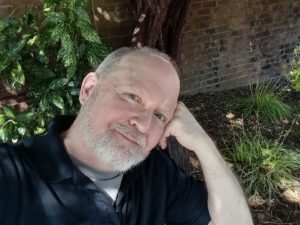When was the last time you heard a French song in Walmart? If you live in small-town South Carolina, the answer is never. A particular tune may top European charts, but Walmart’s catchy in-store radio isn’t known for a cosmopolitan playlist. The chances of a chanson piping in after Michael Sembello’s 1983 Maniac are less than zero. No Vegas bookie would take those odds.
Except today.
I’m driving to town when a random movie memory from Disney’s Angels in the Outfield (1994) pops into my head. A foster care professional, Maggie, asserts that she sees miracles every day. She explains that we don’t think it odd when a football player drops to one knee to thank God. No one laughs if a pitcher crosses himself as he takes the mound. Yet in the film a belief in angels is ridiculed. Maggie is having none of it. “Every child I have ever looked after has someone, an angel,” she says in matter-of-fact tones that brook no argument. “The footprints of an angel are love, and where there is love, miraculous things can happen. I’ve seen it.”
It’s a pleasant scene that I enjoy. My daughter Jess and I saw the movie when she was five years old. This memory is arbitrary, but I’m smiling to myself as I grab a cart and head to the Walmart produce section.
Then it happens.
“Does the voice that we love truly end when it’s stilled?” asks pop star Zaz, singing in her native tongue. I pause and listen to the music overhead. Wait, is that French? “You think we get over it? We live with it, we pretend.” I recognize the song: “On s’en remet jamais” [We Never Really Heal]. It was a modest hit in Europe.
Zaz keeps singing as I stand stunned among the Walmart fruit. “It cuts, it bleeds, an echo under my skin,” she screams in pain belied by the tune’s upbeat tempo. “I dream of drinking your words.” I look around. Other shoppers don’t seem to care that it’s French, but who really listens to background music unless it’s a personal favorite?
Like this song is for me. Jess died in 2015. In her memory I translated English subtitles for We Never Really Heal. This is the first time I’ve heard it in an American store.
Back home I learn that my neighbor of many years died this morning. A fellow bereaved father, Lonnie checked on me continuously after Jess passed. I mention him in the acknowledgements of my first book on grief. His compassion often arrived at just the right moment.
We may not be able to share our sorrow with friends. Yet merely to survive we often seek ways to commune with other mourners. I certainly have. “It is inhuman to wall yourself up in pain and memories as if in a prison,” writes Nobel laureate and Holocaust survivor Elie Wiesel. “Suffering must open us to others.” Austrian-Israeli philosopher Martin Buber refers to this kind of communion as “healing through encounter.” At the 1934 Eranos conference in Switzerland, he spoke on “healing our ‘betweenness,’” suggesting that it is only in shared space that we find true understanding and the will to continue. “A soul never suffers alone,” Buber explains in his influential book I and Thou, “there is always betweenness, a meeting between one person and another.”
Within a week of Jess’s death, Lonnie speaks to me of his struggles when his son passed. The pain never gets easier, he mutters as much to himself as to me. “Will I be able to breathe again?” I ask. “Yeah, you’ll breathe again,” he says. A quiet and robust farmer, he leans on our wooden rail and looks over the fields behind us: “You’ll live with it.” Today I am reminded of this moment as I listen to Zaz. “Will the light return?” she keens. “Will we sleep again?”
A miracle? Perhaps, but not in the way we might think. I have an idea that my daughter whispered in my ear about the movie to prepare me for what she knew was coming—the song and Lonnie—and to assure me that I’m not alone. Few of us are, according to a 1995 study of 1,603 bereaved persons at the University of Nottingham. They discovered that 98.6 percent of us experience our dead in one way or another. Ronald Knapp (Clemson University) puts the number even higher. Of the 300 bereaved couples he interviewed over a decade’s time, 99.3 percent insist they often and continuously feel the presence of their dead children. Many parents experience this within the first few weeks. Later, as months or years go by, they come to feel that their children remain with them, according to grief expert Dennis Klass, professor emeritus at Webster University.
“So much of you is under my skin,” Zaz sings softly. She recorded the tune after a personal loss. Her lyrics share a fact known to all who mourn: “Maybe we never do; we never really heal.” Yet moments like today suggest to me that while our loneliness is painfully real, our aloneness is not.
I’m reminded of shopping in a crowded bookstore some years ago. Loudspeakers are blaring, lights glaring, and there is no chance at all of the proverbial still small voice reaching me. But as I’m flipping through some trade paperbacks, I hear Jess as clearly as if she is standing beside me. “There, that one,” she says as my hand rests on a Samurai Jack graphic novel. “That’s for you, Dad.”
I shake my head. Imagination, I think. And that’s fine. Why begrudge myself a pleasant read if it helps me feel close to Jess? At home I sit down with my new 120-page book. It falls open in my lap to a short story entitled “Father’s Day.” I read of a young boy who with Samurai Jack’s help comes to value his flawed but loving dad. It’s Sunday, June 21, 2015, five months after my daughter died: Father’s Day.
Hearing or seeing our dead loved one is “characteristic of a ‘normal’ grief reaction,” according to the American Psychiatric Association. The experience is so common that it is not considered pathological in any way. Torill Christine Lindstrõm, University of Bergen, finds that the majority of mourners report “sensing experiences” of their dead early in bereavement. These sensations continue for many years, contributing to an ongoing relationship of absence-presence as the bereaved find their emotional and spiritual way after a loss, according to Avril Maddrell (University of the West of England).
“Bereaved people often continue to sense the presence of the deceased,” add experts Craig Murray, Catherine Keen, and Sheila Payne with Lancaster University, “instilling a perception that the deceased person is in some manner present in the company of the bereaved person.” Such experiences have four common characteristics: the sense of presence is personally distinctive, reflecting the deceased’s character and unique aspects of their relationship; prior beliefs play an important role in interpreting the experience; the sensing is usually constructive and helpful; and mourners feel concern about how others might perceive their sensations. Each of these reactions can be healthy, the team notes, and may lead to positive self-perception and meaning-making.
But are our dead truly with us?
German poet Friedrich Rückert thought so. In the spring of 1834, a few months after losing his two youngest children to scarlet fever, he writes a lament that is at once calm, ardent, and deceptively casual:
If our dead are not with us how will we know peace? When we are surrounded by spirits each moment? Awake, we may resist, but in dreams we must succumb. Far more have died than we few who are alive. Can we, clinging to the few, hope to resist the many? When daily, hourly, deserters join their numbers? We who remain, the few, are weak: we cannot resist. Should we not forge an alliance with the strong? Then those who seemed terrible will walk beside us. Then our hearts will open to the lives of the dead. Poets, sages, the wisdom of the ages will rise to meet us. And those we loved will not leave our love in the dust. We will walk this earth in the company of heaven; and those who stood nearest in life will be our closest companions.
Certainly the thought that our dead walk with us is not new. But Rückert writes as if an old idea is suddenly and personally real. He chooses belligerent phrasing—the few, the many, strong, weak, alliance, deserters—to imply that peace comes when we stop resisting the presence of our lost loved ones. They exist whether we are aware of them or not. When we realize this, he says, we walk in the company of heaven. He may be right. Clinicians observe that many mourners develop a practical, livable relationship of continuing love and memory with their dead, according to Nancy Moules with the University of Calgary, “as much filled with comfort and creativity as it is with sorrow.”
Ah, but is creativity merely another word for hallucination? Does grief cause us to imagine our dead loved one’s presence?
Bereavement therapy pioneer Lorraine Hedtke (California State University San Bernardino) notes that while hallucinations require medical care, the majority of such experiences may not fall in that category: “All these responses could lie well within emerging views of normalcy.” For example, widows treated by clinical psychologist Roberta Dew Conant with Outpatient Mental Health at Boston Regional Medical Center report that they often sense the presence of their dead husbands in consoling and helpful ways. “The comparison to hallucinations was voiced spontaneously five times and was always denied,” Conant writes. “These were not hallucinations.”
So what are they?
“God speaks to us, I would say, much more often than we realize or than we choose to realize,” observes theologian Frederick Buechner. “His message is written out for each of us in the humdrum, helter-skelter events of each day.” Divine messages are so personal that they might take an hour to describe. Even then words will likely fail to communicate the unmistakable nature of our experience. “It cannot be explained,” exclaims Thomas Merton of his sacred inspiration on March 18, 1958 in Louisville, Kentucky. “There is no way of telling people that they are all walking around shining like the sun.” As my wife says, such moments are Just for you.
With one whimsical message a terrible mistake is redeemed.
I’m at a local used book sale on January 30, 2016; one year after an overdose ended my little girl’s life. The true crime section has a volume I wrote in 2003 that led to my arrest for criminal impersonation. Bemused, I pick it up, open the cover: “This one’s the best copy because both of us signed it . . . haha! —Jessica.” Thirteen years ago she had inscribed her note above my signature. The buyer didn’t seem to mind that suddenly he had two autographs: the author and his daughter. This copy is the only one of its kind. Any doubt that Jess forgives me disappears. With one whimsical message a terrible mistake is redeemed.
“The holy is below us, not above;” observes Robert Bly in his comment on a Rainier Maria Rilke poem from The Book of Hours. Rilke compares his relationship with the dark, silent, invisible world to a banyan tree. He sees his spiritual life in its living roots:
Yet as much as I lean into myself: my God is dark, like a web of a hundred roots drinking in silence. From this warmth I arise, I know only this, for my branches reach low, stirred by wind and little else.
Banyans are associated with death in India, where they are the national tree. They are often planted outside villages near crematoriums. In Sanskrit the tree’s name, Bahupāda (“many-footed;” called vata in India), refers to its branches that droop low to the ground. A banyan’s numerous prop-roots touch the earth, sink into the soil, and come to resemble new trunks. A single tree can grow multiple boles; old banyans may form an entire wood. One famous tree, over 250 years old, covers 1,347 square meters, with branches that grow as high as twenty-four meters. The oldest banyan is much larger, covering an area of 22,000 square meters. It is 570 years old with prop-roots so large they are described as pillars. Bly sees the banyan as Rilke’s encounter with the divine: “A line moves to descend, to dip down, to touch water that lies so near we are astonished our hands haven’t dipped into it before. The lines suggest holy depth, always distant, always close.”
German Dominican mystic Meister Eckhart writes that we are always close to the divine. Near the end of his life some friends ask Eckhart for a final word of wisdom. He shares what he calls the bedrock of his experience. “Often what we see as trivial is more important to God than we imagine,” he tells them. God’s greatness is in little things that are all around us. The mundane details of daily life are our most accurate measure of spiritual and personal enlightenment. “Rather than delay and hunt for God using some special method,” Eckhart says, “it has been my joy to experience God in all actions and in all things.”
Israel’s prophets and sages were forever hearing from God unprompted, not in response to a human request, but because He would have words with them. This is a common feature of the Old Testament, notes James Kugel, professor emeritus of Hebrew at Harvard and at Bar Ilan University in Israel. Yet the Bible seems to stress that these encounters with the divine usually took the form of ordinary people or objects from everyday life. “If biblical stories are any kind of guide, people in ancient times encountered God,” he says. “What was the actual, lived reality of God in biblical times, and why have most people lost it today?”
Perhaps we have lost only our awareness of it, writes Martin Buber. He notes that God encounters us through a grace that cannot be sought or generated through our efforts. Goals, expectations, and longing get in the way: “All methods are obstructions. Only when all methods have fallen does encounter occur.” The more we listen for that still small voice, Buber suggests, the less likely we are to hear it. His word choice is telling. As he uses it, encounter (Begegnung) represents an event solely significant to us that then informs our lives. We experience God’s influence by simply being, simultaneously choosing and being chosen. “I cannot make this gathering and merging into a whole being happen; it cannot happen without me,” he says. “All true living is encounter.”
This seems to be the way of miracles. I didn’t anticipate hearing a French pop song in the Walmart produce section this morning; a message from Jess seemed impossible on that busy Father’s Day in 2015; and I had forgotten all about her co-signing my book over two decades ago. These possibilities never occurred to me. I could just as easily have overlooked them. Eugene Peterson observes that God makes himself known in many ways, “from the macro to the micro, from the wonders of the galaxies to the little things we take for granted.” Perhaps our relationship with God exists regardless of our seeking it, acknowledging it, or even recognizing it.
“You’re not so far, not so high,” Zaz realizes. “I’m an orphan of your words: their echoes remain; I carry you in my skin.” I know the feeling. Author Isabel Allende once said that she wears her dead daughter Paula like a second skin. It may be we need do nothing more than accept that our loved ones continue on. We don’t have to search for them; they are with us anyway.
My miracles are many, too many to count or explain. Maybe yours are too. But none matters more than knowing God and Jess are with me. I feel them now, as I felt them this morning in a crowded store.
However great our suffering, it passes through God, God endures it first. Yes, in the truth that is God himself, no suffering is so trivial, so minor or grotesque, that placed in him, God does not know, does not feel unfathomably deeper, than we do ourselves. The light is there in the dark. In the dark, in suffering, we see the light most clearly.
—Meister Eckhart
All translations from French and German are by David Bannon.
Image Credit: Karon Elliott Edleson via Flickr






